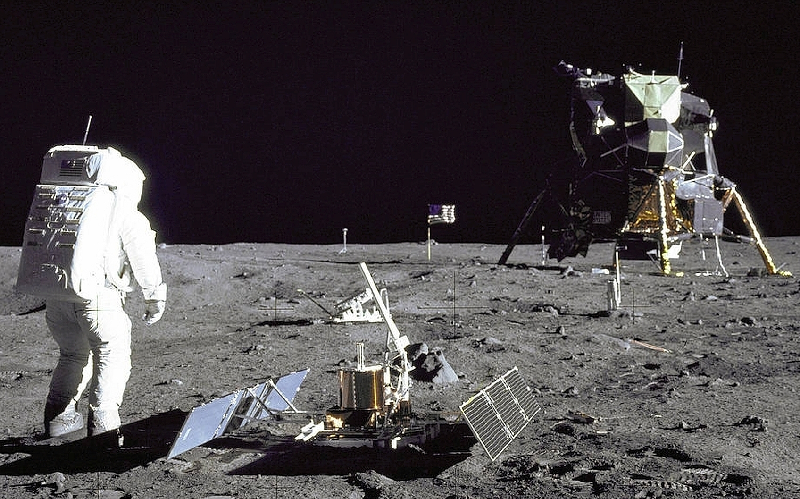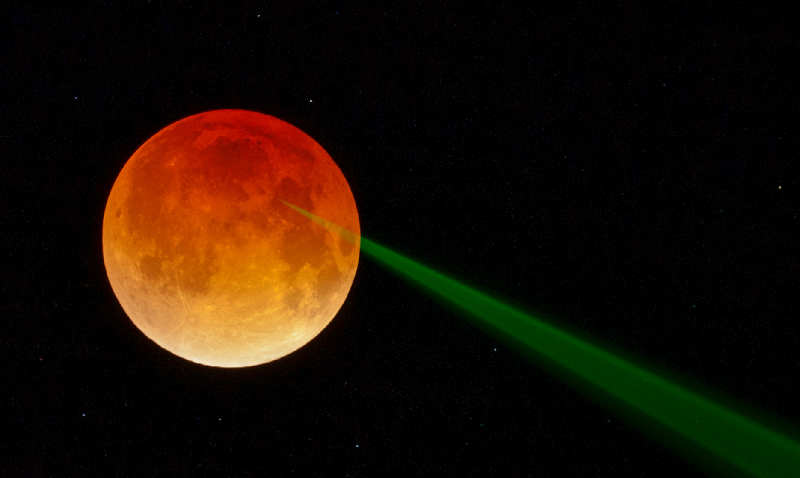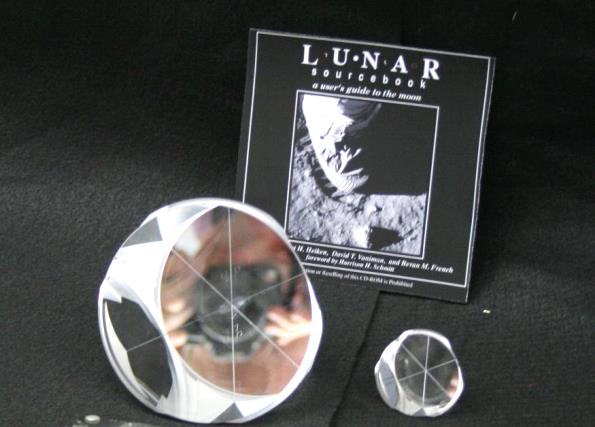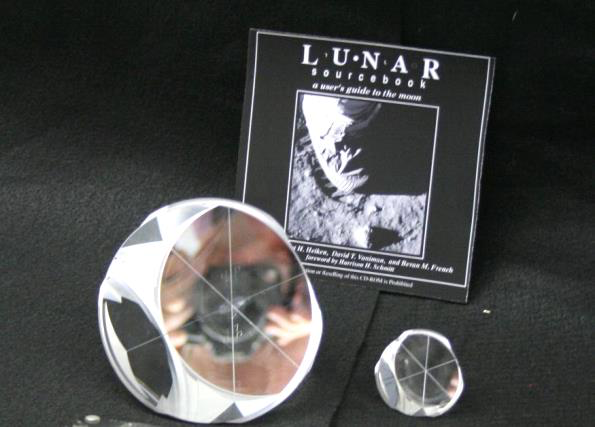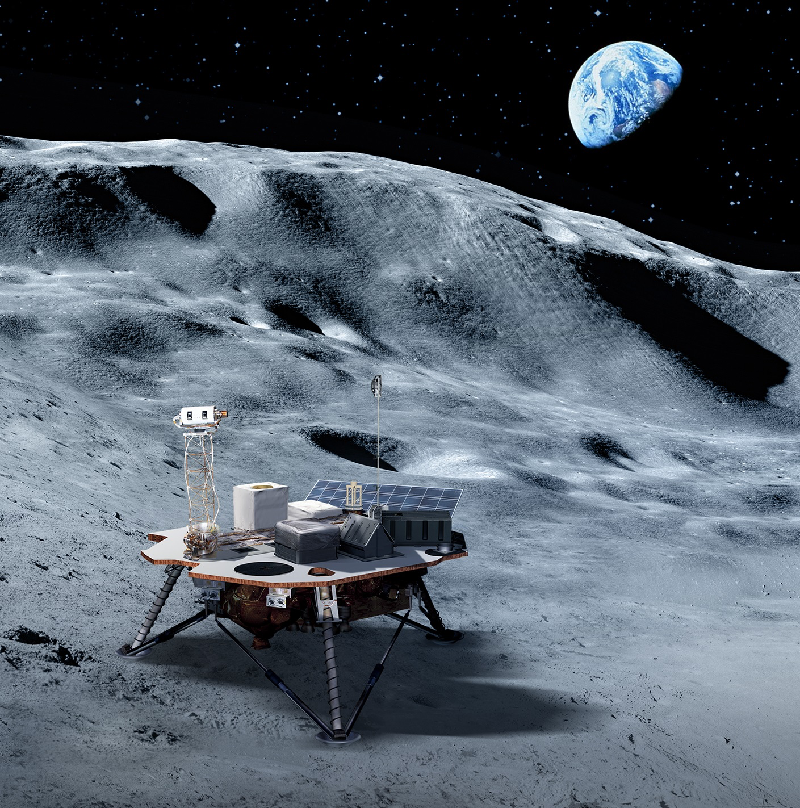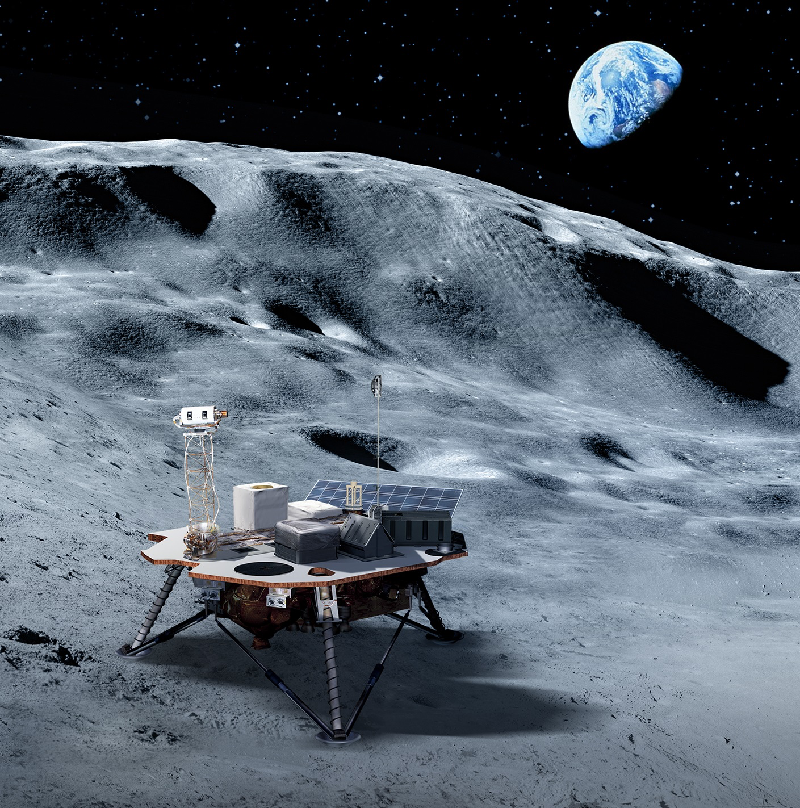Physics from the Moon
The Apollo 11 mission is remembered primarily as a technological feat—epitomized by a first footprint in lunar soil—but it was also a scientific achievement. When Neil Armstrong and Buzz Aldrin stepped out of the Eagle Lander on July 20, 1969, they installed several small measuring devices including a seismometer, a solar wind particle collector, and an array of reflectors meant to bounce laser pulses back to Earth. These instruments—and others brought by subsequent Apollo missions—remained on the Moon long after the humans left. They provided a number of key results, such as observing the first moonquakes and measuring the makeup of the lunar interior. “The Apollo scientific legacy has been enormous and underpins much of our understanding of the terrestrial planets,” says planetary scientist Ian Crawford from the University of London.
For the physics community, the biggest payoff from the Apollo science program has come from the reflector arrays, which are part of the lunar laser ranging (LLR) experiment. For 50 years and counting, scientists have been pinging laser pulses off these reflectors to measure the Moon-Earth distance to high precision. By treating our rocky satellite as a giant test mass, the LLR research program has tested several predictions from gravity theory at unprecedented levels. Thanks to these successes, an updated LLR reflector is now scheduled to fly back to the Moon on a commercially built lander. Other physics-related projects, such as radio telescopes on the far-side of the Moon, may be able to piggyback on future crewed missions. As in the Apollo years, the exploration of our planet’s cosmic companion continues to offer new opportunities for physics research.
Lunar Laser Ranging Turns 50
The first LLR array was deployed during the Apollo 11 mission, but other arrays were installed during Apollo 14 and 15 and as part of the Soviet Union’s robotic Luna program. An array consists of between 14 and 300 retroreflectors, each of which is a piece of glass shaped like a corner sliced off of a solid glass cube. Light entering a retroreflector reflects off of all three mutually perpendicular back surfaces and exits in the direction it came from. Researchers on Earth measure the round-trip travel time—roughly 2.5 seconds—of laser pulses reflecting off these retroreflectors and returning back to detectors on Earth. The first laser reflection to be recorded was at Lick Observatory in California on August 1, 1969, but since then several other facilities in the US, the Soviet Union, France, and elsewhere have used the LLR arrays.
As the retroreflector arrays require no power, they remain the only astronaut-installed equipment still in operation on the Moon. “The LLR experiment has been surprisingly long-lived, and it has given us an impressive record of results,” says Tom Murphy from the University of California, San Diego, who is the lead investigator of the Apache Point Observatory Lunar Laser-ranging Operation (APOLLO)—which has been running since 2005. From a mountain top in southern New Mexico, Murphy and his colleagues fire 100-picosecond laser pulses at one of the five LLR arrays on the Moon and capture the return light. The efficiency is miniscule: only about one out of 1018 emitted photons makes the complete return trip to the detector. But even with just a few detected photons, researchers can measure the travel time and from that determine the Moon-Earth distance to roughly the nearest millimeter.
Like other LLR researchers, Murphy’s team tracks the orbit of the Moon over time, and with those data they can perform several tests of gravitational theory, such as confirming Einstein’s equivalence principle, verifying the constancy of Newton’s gravitational constant, and placing limits on deviations from the expected 1∕r2 law of gravity. In many cases, LLR provides the most precise tests of any experiment (see 16 November 2017 Synopsis).
“We are fortunate to have the Moon,” Murphy says. The Moon is far enough from Earth that it is essentially in orbit around the Sun (the Moon’s path around the Sun barely differs from the Earth’s path). This surprising fact is important because the tests of gravity theory look for perturbations in the Moon’s solar orbit caused by the Earth. If the Moon were closer, then Earth’s gravity would dominate the Moon’s motion, and the current testing strategy wouldn’t work. If the Moon were farther, not enough light would bounce back. “If we were living on Mars, the same gravity tests with one of its moons—Phobos or Deimos—wouldn’t be as precise,” Murphy says.
LLR Due for Facelift
The LLR experiments were not expected to last this long, says Doug Currie from the University of Maryland, College Park, a developer of the Apollo retroreflectors. One of the early concerns was that lunar dust kicked up by meteorites would cover the retroreflectors and thus limit their operational time to just a few years. “Dust has been a problem,” Currie says, but not as severe as originally predicted. “Laser [technology] has grown faster than the dust has accumulated.”
In fact, the precision of LLR experiments has continuously increased, from 150 millimeters in the 1970s to a few millimeters now. To reach even higher precision, scientists will have to deal with lunar “libration,” which is a wobbling in the Moon’s orbital position that causes the reflector arrays to tilt back and forth slightly with respect to observers on Earth. “We don’t know if an observed photon came from the near or the far corner of the array,” Currie explains. This uncertainty over the photon’s exact path translates into an error in the Moon-Earth distance estimate.
To overcome the effects of libration, Currie is now working on a new project: the Next Generation Lunar Retroreflector (NGLR). This updated reflector is designed to stand alone, rather than in an array, which means that there’s no uncertainty about which reflector a photon is coming from. To compensate for not having the collective effect of multiple reflectors, Currie’s team made NGLR larger than earlier versions, giving it a diameter of 100 mm, as compared with 38 mm for the Apollo reflectors. Using NGLR, the Moon-Earth distance could be measured at submillimeter precision, which would allow researchers to look for deviations in the Moon’s orbit predicted by certain alternatives to the general theory of relativity.
The Race to Go Back
Currie’s retroreflectors should be going to the Moon in the next few years, as the project was selected on 1 July for NASA’s Commercial Lunar Payload Services (CLPS) program. The CLPS program is a partnership between NASA and private companies that are developing lunar landers. NASA has already commissioned three commercial Moon landing service providers to deliver scientific and technological instruments, such as a fast-moving rover and two sample-acquisition devices. In the big picture, the CLPS program is laying the groundwork for NASA’s Artemis program, which aims to land astronauts on the lunar surface by 2024 and to create a sustainable human presence by 2028. In parallel, both China and India have recently sent orbiters and landers to the Moon.
What might physicists expect to gain from this new space race? Several researchers have begun arguing for radio antennas on the far side of the Moon. “That’s where we want to go in the next decade,” says astrophysicist Jack Burns from the University of Colorado, Boulder. The Moon’s far side, which always faces away from Earth, is one of the most radio-quiet places in the solar system because it is shielded from the electromagnetic noise of Earth’s communication network. The Moon also lacks the Earth’s thick ionosphere, so low-frequency radio waves (less than 30 MHz) can reach the lunar surface.
Several efforts are being made to test the feasibility of radio astronomy from the Moon. The Chinese space agency installed a small radio spectrometer on its Chang’e 4 spacecraft, which landed on the far side of the Moon in January of this year. Similarly, Burns and colleagues—led by Stuart Bale at the University of California, Berkeley—have developed the Lunar Surface Electromagnetics Experiment (LuSEE), which has a low-frequency radio antenna for picking up solar flare activity, as well as radio emissions from Jupiter and other planets. Like NGLR, LuSEE will soon hitch a ride to the Moon on one of the CLPS commercial landers.
The long-term goal is to use radio telescopes to study the “dark ages,” the time before the first stars formed about 400 million years after the big bang (see 2 July 2018 Viewpoint). Understanding that early epoch could reveal new information about dark matter and allow tests of cosmic inflation, the theory that the Universe expanded rapidly immediately after the big bang, before expanding more slowly. To probe the dark ages, Burns and others—like Joe Silk from the Institute of Astrophysics in Paris—advocate setting up an array of antennas on the Moon’s far side. At a recent cosmology conference in Spain, Silk said such an array would not be too hard to build, and it would add a broader scientific purpose to the next round of crewed missions to the Moon.
As demonstrated with Apollo, scientific research and human exploration can have a mutually beneficial relationship: the science helps to legitimize the cost of crewed missions, while at the same time the large collective effort of an astronaut program provides a boost to research. Although robotic missions are often less expensive, they are generally less efficient in the amount of science they accomplish, Crawford argues [1]. “The argument that much of Apollo science could have been done robotically is a red herring—some of it could have been, some of it couldn't, but the point is most of it would not have been done otherwise,” he says.
Michael Schirber is a Corresponding Editor for Physics based in Lyon, France.
References
- I. A. Crawford, “Dispelling the myth of robotic efficiency,” Astron. Geophys. 53, 2.22 (2012).





